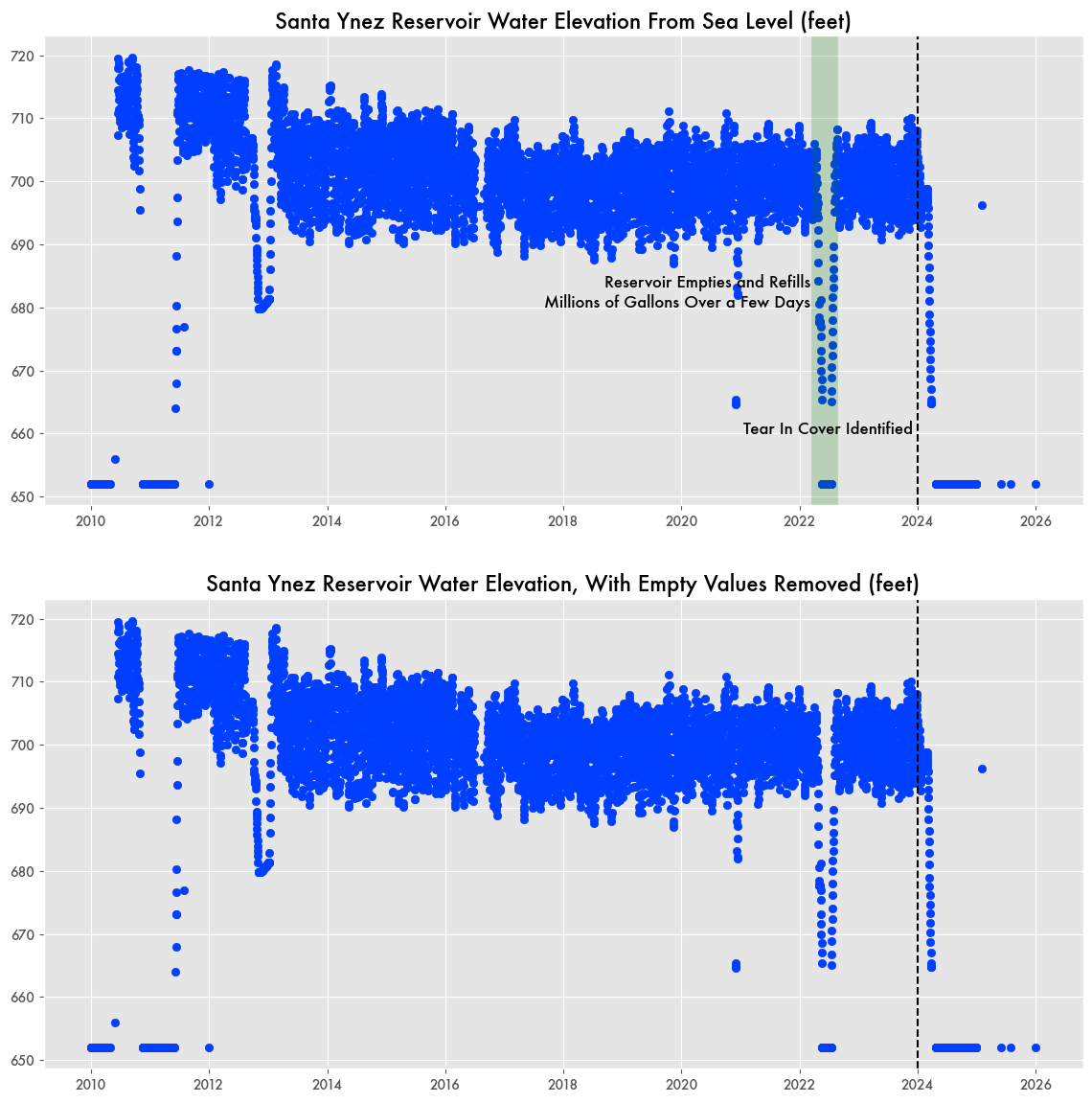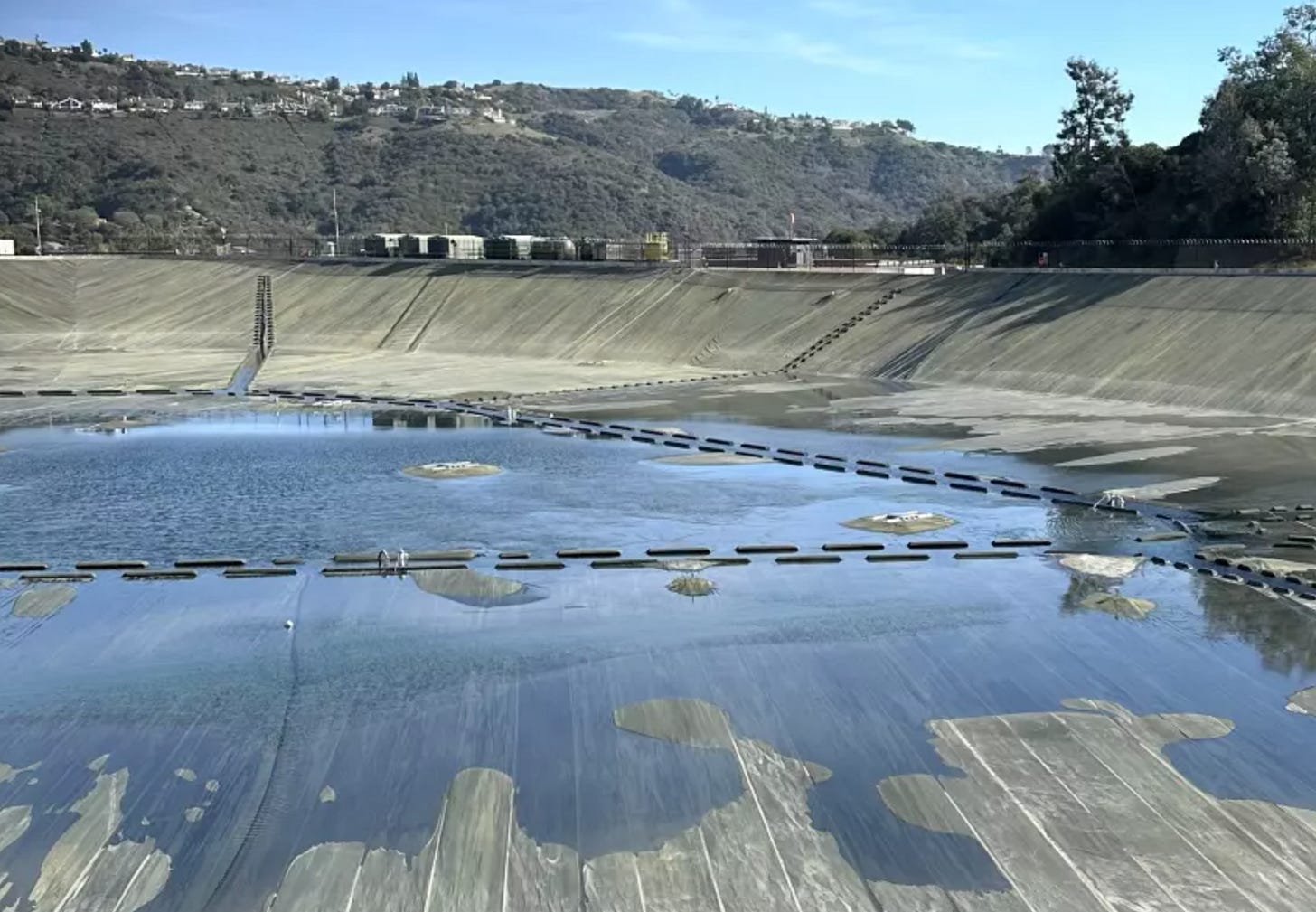The Santa Ynez Reservoir Wasn't Reporting Large Outflows
Edit (2025-04-27): This story was substantially edited to correct the total elevation of the reservoir to be 69 feet along with subsequent calculations.
One of the major complaints by Los Angeles residents to the fires that ravaged the city earlier this year is that the nearby Santa Ynez Reservoir was empty and therefore unable to provide water for firefighting.
Firefighters quickly ran out of water during the blaze, leaving the fire to burn through homes uninterrupted. Over 12,000 structures were destroyed and the damage is estimated to be over $30 billion. An investigation was announced in January about why the reservoir was empty, and whether or not it could have helped fight fires.
The reservoir had been shut down since 2024 due to a tear in its plastic cover—effectively a large tarp meant to keep out debris and improve water quality—so according to a post on the Los Angeles Department of Water and Power (LADWP) site, it was empty. Earlier this week it was announced that the reservoir would have to be drained another time to help fix another leak.
But it hard to tell if the reservoir was actually empty or just reported as empty. Reports for Santa Ynez show no details of water outflow in recent years a despite drastic changes in water elevation.
Throughout 2023, reports from LADWP on reservoir levels showed it averaging 700 feet of elevation above sea level out of a maximum operating level of 721 feet— around 30 percent full. At the time that someone noticed the tear in its cover in January of 2024, reports showed it at 700 feet above sea level—70 percent of its 117 million gallon capacity based on a maximum depth of 69 feet. The L.A. Times reported that it held around 50 percent of total capacity.
That would still be a substantial 56 million gallons of water. According to the Times story, draining the reservoir completely of even that much water is a process that “can take up to two months.”
Yet reports show millions of gallons disappeared from the reservoir in just three days over the weekend between March 28th, 2024 and April 1st, 2024 with no specified outflow, leaving it completely empty. The largest drop in a day was 35 feet, which would mean the reservoir would only take two days to empty.
It’s not the first time water suddenly disappeared from the reservoir. It happened at different times in 2010 into May of 2011. Then it happened again from May 19th to July 15th of 2022 only to be refilled to 70 percent of maximum elevation a day later, all while Los Angeles was in the middle of a severe drought that year.
No Reported Outflow Capacity Since 2017
Despite the reservoir regularly being emptied, there was no reports of changes to outflow going back to 2017.
Before 2017, weekly reports from Santa Ynez showed regular variance of potential maximum outflow rate—usually around 1,315,937 (potentially gallons per minute)—up until September 3rd of 2017 when it was noted that all pumps were in overload condition. Those pumps would continue to be inactive into the next week with a comment stating “All Six Overload Trips Reset (don’t know when or by whom).”
From that day forward for the next seven years reports would simply list outflow capacity as “b/o”—meaning “balance of” as if nothing had changed and it was no longer being reported.
No Real Need to Close the Reservoir
Closing the reservoir because of a tear in the cover was done ostensibly to be in compliance with federal clean water regulations, but that only pertains to reservoirs built after 2002. Use of the Santa Ynez Reservoir began back in 1970.
Pictures of the reservoir on the L.A. Times website make it appear to be empty, but it doesn’t show the full depth—just to the top of the foundation walls at the spillway. The image makes the reservoir appear to only be around 20 to 30 feet high when the full reservoir actually goes down at least another 39 feet.
Water is a precious commodity in southern California—for the large resident population, large agricultural industry, and for firefighters—and the city spends a lot to acquire it.






[(Edit, 4/26/25)
My correction of author's 700' depth to 325' is ALSO incorrect! Yes, I screwed that up, with only a little help from Google AI. Sorry, and thanks to author Llewellyn Jones for engaging & causing me to verify...]
------------
Go look at the multiple pictures in MSM labeled as "Pacific Palisades" and "Santa Ynez Reservoirs", many are mis labeled, many more presented as being the current state at time of fire showing no water (or very little) were taken years before the recent fire.
BTW, the Santa Ynez Reservoir has a maximum depth of 325 feet, not 700'.
Alternative media can be just as useless and full of shit as MSM.